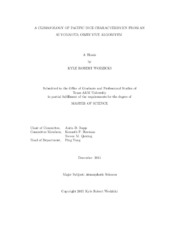| dc.description.abstract | The Intertropical Convergence Zone (ITCZ) is a main driver of the Hadley circu-lation and a large component of the hydrologic cycle. With recent studies indicating changes in the width and strength of the Hadley circulation it is possible that changes in ITCZ characteristics may be related to these changes. The goal of this study is to identify changes in the characteristics of the ITCZ that have occurred over the past three decades. The automated ITCZ identification algorithm of Berry and Reeder is modified and applied to ECMWF Reanalysis Interim (ERA-Interim) variables and the ITCZ latitude at each longitude is used as a starting point to objectively char-acterize ITCZ width and intensity. TRMM Microwave Imager (TMI) and Global Precipitation Climatology Project (GPCP) rain rates (RRs) are used to examine the 15- and 36-year climatologies, respectively, of northern and southern ITCZ con-vection boundaries, ITCZ width, and precipitation intensity within the center and across the entire ITCZ extent in the tropical Pacific. The climatological location of the ITCZ was found near 8◦N, consistent with previous studies, with a preferred southern boundary location of 4◦S. The northern ITCZ boundary did not exhibit a preferred boundary with locations between 7◦ − 15◦N having similar frequencies of occurrence. The northern and southern extents of the ITCZ were symmetric in the central Pacific and asymmetric in the east Pacific. Long-term trends in the width and ITCZ precipitation intensity showed narrowing and intensifying trends signifi-cant at the 95% confidence level. Separation of characteristics by season and location (i.e., central and eastern Pacific) revealed negative trends in the width of the ITCZ in both domains, with trends in the east Pacific weaker than those in the central Pacific. Trends in precipitation intensity near the center of the ITCZ indicate even more precipitation intensification than over the whole ITCZ, with slightly stronger trends in the central Pacific than in the east Pacific. Interestingly, regression of monthly mean ITCZ width and intensity are positively correlated, indicating heavier mean RR when the ITCZ is wider. These findings show that while the mean center location of the ITCZ has not changed significantly over the past three decades, the ITCZ has narrowed and precipitation has intensified; however, the different mechanisms that drive relationships between ITCZ width and precipitation intensity at different timescales is still unclear. | en |


